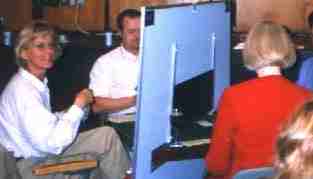

You are at the Contract Bridge recreations page of Dr Chris Ryall, I play in competitions organised by the English and Welsh Bridge unions, at clubs in Merseyside & Cheshire and Manchester areas of England, online and occasionally in continental Europe.
When not playing bridge I am a medical man, working as a radiologist in the Liverpool teaching hospitals. I enjoy Anglo/European folk tradition - English song, French bal traditionnelle dance, and playing diatonic accordeon.
A large archive of Weak two preemptive methods.
I have collected these together from across the world over several years and now
have 75 (in 2005) distinct styles.
![]()
![]() Weak two methods vary a lot internationally with single, two, and even three
suiters, weak/strong combines and some that barely specify a suit.
The "New Wave" development in recent years is "assumed fit preempting showing just 4/4
in two suits. Thuis was originally majors, now in several flavours and advanced particularly by
Norwegian player Bjørn Ekren. The style is spreading fast may often be
"unrestricted" if the suit bid is held - so you will need to discuss a defence. I hope you
might give the Weak
Two Archive a look.
Weak two methods vary a lot internationally with single, two, and even three
suiters, weak/strong combines and some that barely specify a suit.
The "New Wave" development in recent years is "assumed fit preempting showing just 4/4
in two suits. Thuis was originally majors, now in several flavours and advanced particularly by
Norwegian player Bjørn Ekren. The style is spreading fast may often be
"unrestricted" if the suit bid is held - so you will need to discuss a defence. I hope you
might give the Weak
Two Archive a look.
![]() I am interested in the theory of what I term paradox bids, in which you call
the suit you haven't got in response to a conventional bid that shows ambiguously one of two suits. Paradox turns
our to have enormous application in Bridge (beyond pass/correct systems), but no one seems to have really tied the underlying
theory together before. You can play paradox responses to 1NT, or opposite a big
2
I am interested in the theory of what I term paradox bids, in which you call
the suit you haven't got in response to a conventional bid that shows ambiguously one of two suits. Paradox turns
our to have enormous application in Bridge (beyond pass/correct systems), but no one seems to have really tied the underlying
theory together before. You can play paradox responses to 1NT, or opposite a big
2 (with Acol major
twos) Paradox is actually the "standard" reply to partner's Multi 2
(with Acol major
twos) Paradox is actually the "standard" reply to partner's Multi 2 .
I have now seen ParadoX against me at the table in Holland in '99, more recently
in Britain, and am starting to see web links to my page.
.
I have now seen ParadoX against me at the table in Holland in '99, more recently
in Britain, and am starting to see web links to my page.
I pasted our approach to competing 1NT contracts here simply to explain some of the wierd calls I make at the table, but it has proved a popular download. Click the dogfight icon for more
![]() As EBU don't seem to do notes on UK Acol bidding I have
made my own notes on Acol reflecting what
I see at the table or online
As EBU don't seem to do notes on UK Acol bidding I have
made my own notes on Acol reflecting what
I see at the table or online
There is also an idiosyncratic set of edited r.g.b threaded discussions. So far the Wilkosz opening, defending strong Club, using 5 card puppet Stayman and brown sticker conventions in general. Usenet can be retrieved from Google, but I can recommend these debates as useful, and have edited out the cyber-clutter amd a few "flames". They are still very large files!

I like to vary 1NT depending on conditions. Like most UK pairs we had started out with "standard" 12-14 range, but our experience (and pairs play) led us to polarise into either an aggressive 9+ mini nv - strong 4th/vul.
A nice spin-off of 9+ NT is that by 3rd position you know there isn't a balanced 9 count over there!
 It becomes safe (and logical!) to open 1NT on anything from
9 to a bad 16.
Not vulnerable, an undoubled 1NT is almost never a
poor contract. Similar logic applies to other borderline decisions in 3rd/4th.
It becomes safe (and logical!) to open 1NT on anything from
9 to a bad 16.
Not vulnerable, an undoubled 1NT is almost never a
poor contract. Similar logic applies to other borderline decisions in 3rd/4th.
We hear 1NT (x) pretty often! We've put a lot of work into our wriggles and continuations planning to back our judgement and experience against yours.
An unexpected side effect of not playing 12-14 was that it paid to
invert the
meanings of 1 /1NT responses to
1
/1NT responses to
1 , allowing opener to express that common 13-14
balanced hand.
, allowing opener to express that common 13-14
balanced hand.
I have long stopped calling our system Acol - for example we play a 5+ spades, 4+ hearts and occasional 3+.club. I like 2/1 as "generally game forcing" over majors, but a Bourke relay works better for the minors.
fit jumps 2/1 and the relay allow us to free up the jump shift as a preemptive fit bid, which works very well. Generally we attempt to hit our games in about 3 bids. We operate on losing count and jump wherever possible - even opposite partner's 1NT opening! Folk describe us as "aggressive" but it's there on the front of the card. We call our overall system "Betty", after a lady who complained that it didn't have a name!

I got interested in Journalist leads initially popularised some 20 years ago by Rosler and Ruben. As there seems to be nothing previously on the Web I have set up my own page (which may change later). Joan agreed to play on trial, but said she didn't really like them - so we have gone back to traditional methods.
 I extend the usual strong
2 clubs opening to include both major 8+ trick "Acol strong two's" and
16+ three suited
types. All made possible by ParadoX major negatives to the
2
I extend the usual strong
2 clubs opening to include both major 8+ trick "Acol strong two's" and
16+ three suited
types. All made possible by ParadoX major negatives to the
2 opening - keeping the auction low.
opening - keeping the auction low. My style of Multi 2 diamond
is fairly mainstream expressing weak 6-card majors, big minor hands and the
22-24 notrump range. Note that this frees up major twos for further preempts
My style of Multi 2 diamond
is fairly mainstream expressing weak 6-card majors, big minor hands and the
22-24 notrump range. Note that this frees up major twos for further preempts I don't find traditional heart preempts too effective, and prefer my
2 hearts as a
"new wave" assumed
fit style showing 4/4 or better in the majors. Well worth a look, especially
if this syle is new to you - very much in fashion!
I don't find traditional heart preempts too effective, and prefer my
2 hearts as a
"new wave" assumed
fit style showing 4/4 or better in the majors. Well worth a look, especially
if this syle is new to you - very much in fashion! has evolved from an
early Lucas two
into "spades and a minor" in the Dutch "Muiderberg" style. Except that I advance using 2NT
as Lebensohl
and ParadoX methods. I've given up Muiderberg 2
has evolved from an
early Lucas two
into "spades and a minor" in the Dutch "Muiderberg" style. Except that I advance using 2NT
as Lebensohl
and ParadoX methods. I've given up Muiderberg 2 in favour of assumed fit.
in favour of assumed fit.
 is nicely researched and well organised (in English/French).
is nicely researched and well organised (in English/French).
Click the icon for a (15.7k zipped) system card in simple MSWord format. It is set up for A4 Brother laserjet 4L and might need slight tweaking for other printers.
Web page freaks (like me) might look at these links to paste in ParadoX amd Weak Two HTML links. Obviously I'm hoping for a link from your site, but to tempt you these pages also contain links to utilities I use, tips on Web design, tricks to debug your style sheets and to validate your HTML code.
|
|
www.chrisryall.net/bridge © Chris Ryall 1987-2008
|